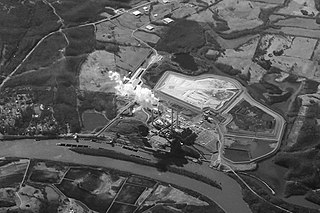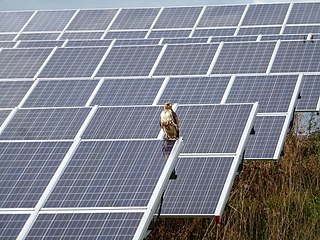
American Electric Power Company, Inc. (AEP), is an American domestic electric utility company in the United States. It is one of the largest electric utility companies in the country, with more than five million customers in 11 states.
DTE Electric Company was founded in 1886.

The Yallourn Power Station, now owned by EnergyAustralia a wholly owned subsidiary of the Hong-Kong–based CLP Group, is located in the Latrobe Valley of Victoria, Australia, beside the Latrobe River. Yallourn PS was a complex of six brown coal–fired thermal power stations built progressively from the 1920s to the 1960s; all except one have now been decommissioned. Today, only the 1,450 megawatts (1,940,000 hp) Yallourn W plant remains. It is the second largest power station in Victoria, supplying 22% of Victoria's electricity and 8% of the National Electricity Market. The adjacent open cut brown coal mine is the largest open cut coal mine in Australia, with reserves sufficient to meet the projected needs of the power station to 2028. On 10 March 2021, EnergyAustralia announced that it will close the Yallourn Power Station in mid-2028, four years ahead of schedule, and instead build a 350 megawatt battery in the Latrobe Valley by the end of 2026. At the time, Yallourn produced about 20% of Victoria's electricity.

Consumers Energy is an investor owned utility that provides natural gas and electricity to 6.7 million of Michigan's 10 million residents. It serves customers in all 68 of the state's Lower Peninsula counties. It is the primary subsidiary of CMS Energy. The company was founded in 1886 and is currently headquartered in Jackson, Michigan.
The Keystone Generating Station is a 1.71-gigawatt, coal power plant located on roughly 1,500 acres (610 ha) in Plumcreek Township, southeastern Armstrong County, Pennsylvania near Crooked Creek, just west of Shelocta, Pennsylvania.

Cumberland Fossil Plant is a pulverized coal-fired power station located west of Cumberland City, Tennessee, US, on the south bank of Lake Barkley on the Cumberland River. Owned and operated by Tennessee Valley Authority (TVA), it has a gross capacity of 2,470 MW, and is the most powerful power station in Tennessee.

The W. H. Sammis Power Plant was a 2.23-gigawatt coal power plant in Stratton, Jefferson County, Ohio. The plant was operated by Energy Harbor. It began operations in 1960.

The Gibson Generating Station is a coal-burning power plant located at the northernmost end of Montgomery Township, Gibson County, Indiana, United States. It is close to the Wabash River, 1.5 miles (2.5 km) southeast of Mount Carmel, Illinois, 2 miles (3.2 km) south of the mouth of the Patoka River, and 4 miles (6.5 km) south of the mouth of the White River. The closest Indiana communities are Owensville 7.5 miles (12 km) to the southeast of the plant, and Princeton, 10.5 miles (17 km) to the east. With a 2013 aggregate output capacity among its five units of 3,345 megawatts, it is the largest power plant run by Duke Energy, and the tenth-largest electrical plant in the United States. Given the closure of the Nanticoke Generating Station in Ontario, in 2013, the Gibson Generating Station became the largest coal power plant in North America by generated power.

The Saint Clair Power Plant was a major coal- and oil-fired power plant owned by DTE Electric, a subsidiary of DTE Energy. It was located in St. Clair County, Michigan, on the west bank of St. Clair River. The plant was across M-29 from the newer Belle River Power Plant in East China, Michigan. The first four units of St. Clair were built in 1953–1954. Since then, three more generating units were added to the plant. The St. Clair Power Plant generated 1982 megawatts in total. It was Detroit Edison's second largest power producer. The power plant has a large impact on the local economy, employing about 300 workers. The plant shut down in May 2022.
Belle River Power Plant is a major coal-and-natural gas-fired power plant owned by Detroit Edison, a subsidiary of DTE Energy. It is located in St. Clair County, Michigan, on the peninsula formed by the St. Clair and Belle rivers. The plant was built across M-29 from the St. Clair Power Plant in East China, Michigan, and shares the coal delivery terminal with it. The Belle River plant also shares cooling water from the St. Clair River with its sister plant. Five oil-fueled internal combustion generators were built in 1981, with a total output 13.75 megawatts. Coal-fired unit 1 of the Belle River plant was completed in 1984, followed by a similar unit 2 in 1985. Each unit has a nameplate capacity of 697.5 MWe, however the coal-fired plant as a whole generates 1260 MWe all year around. In 1999, three peaker natural-gas fired turbines were added, with a total name-plate capacity of 256 MWe.
Warrior Run Generating Station, owned by the AES Corporation, was a 205 megawatt cogeneration plant located south of Cumberland, Maryland, United States, at 11600 Mexico Farms Road. In addition to electric power, the plant also produced food-grade carbon dioxide.

F. B. Culley Generating Station is a 369 megawatt (MW) coal power plant located southeast of Newburgh in Warrick County, Indiana. It sits on the north bank of Ohio River, immediately adjacent and upstream of the Warrick Power Plant, and is owned and operated by Vectren.
The Harding Street Station is a 12-unit, 1,196 MW nameplate capacity, gas-, coal, and oil-fired generating station located at 3700 S. Harding St., in Indianapolis, Indiana, U.S. It is owned by AES Indiana, a subsidiary of AES. Completed in 1973, Harding Street Station's tallest chimneys are 565 feet (172 m) in height.

The Trenton Channel Power Plant, also known as the Trenton Stacks, was a coal-burning power station located in Trenton, Michigan. Completed in 1924, it is owned by Detroit Edison, a subsidiary of DTE Energy.

Solar power in Michigan has been growing in recent years due to new technological improvements, falling solar prices and a variety of regulatory actions and financial incentives. The largest solar farm in Michigan is Assembly Solar, completed in 2022, which has 347 MW of capacity. Small-scale solar provided 50% of Michigan solar electricity as recently as 2020 but multiple solar farms in the 100 MW to 200 MW range are proposed to be completed by the middle of the decade. Although among the lowest U.S. states for solar irradiance, Michigan mostly lies farther south than Germany where solar power is heavily deployed. Michigan is expected to use 120 TWh per year in 2030. To reach a 100% solar electrical grid would require 2.4% of Michigan's land area to host 108 GW of installed capacity.

The Sherburne County Generating Station, also known as Sherco, is a large coal-fired power plant on the banks of the Mississippi River in Becker, Minnesota, which is in Sherburne County. Its three units have a combined capacity of 2,238 megawatts, making it the largest power plant in the state. In comparison, the single-unit Monticello Nuclear Generating Plant located less than four miles away has an output of 671 MW. The state's other nuclear power plant, the 2-unit Prairie Island facility, is rated at 1,096 MW, so Sherco has a larger peak output than those plants put together. The station uses 20,000 to 30,000 tons of coal per day. The BNSF Railway delivers up to three 115-car trains per day from mines in the Powder River Basin.

Brayton Point Power Station was a coal-fired power plant located in Somerset, Massachusetts. It was the largest coal-fired generating station in New England, and was the last coal-fired power station in Massachusetts to provide power to the regional grid. It had been owned by the power company Dominion Energy New England since 2005, after it was purchased from PG&E. The plant was owned from August 2013 to April 2015 by Energy Capital Partners, and is now owned by Dynegy. The plant ceased power generation and went offline on June 1, 2017.

The Calaveras Power Station is a series of power plants located southeast of San Antonio, in Bexar County, Texas, near Calaveras Lake. These plants include the J.T. Deely Power Plant, the O.W. Sommers Power Plant, and the J.K. Spruce Power Plant. They are operated by CPS Energy.

The Dan E. Karn Power Plant is a multi-fuel power station located in Essexville, Michigan. It is adjacent to the location of the former J.C. Weadock Power Plant Power Plant, which closed in 2016.















